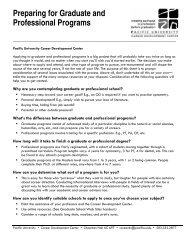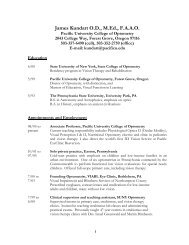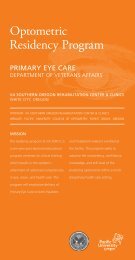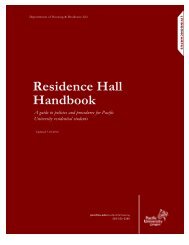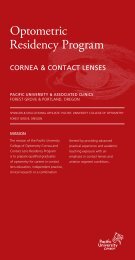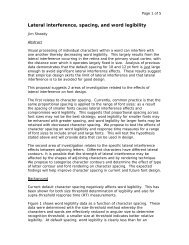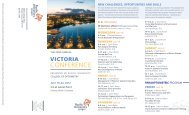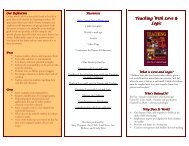An Arabic Tagset for the Morphosyntactic Tagging of Arabic
An Arabic Tagset for the Morphosyntactic Tagging of Arabic
An Arabic Tagset for the Morphosyntactic Tagging of Arabic
Create successful ePaper yourself
Turn your PDF publications into a flip-book with our unique Google optimized e-Paper software.
A tagset <strong>for</strong> <strong>the</strong> morphosyntactic tagging <strong>of</strong> <strong>Arabic</strong><br />
Shereen Khoja<br />
Computing Department<br />
Lancaster University<br />
Roger Garside<br />
Computing Department<br />
Lancaster University<br />
Gerry Knowles<br />
Linguistics Department<br />
Lancaster University<br />
1. Introduction<br />
Principles <strong>for</strong> allocating grammatical parts-<strong>of</strong>-speech <strong>for</strong> words have been around <strong>for</strong> fourteen<br />
centuries, and <strong>the</strong> principles used today vary very little from <strong>the</strong> principles used <strong>the</strong>n.Yet <strong>the</strong>re is no<br />
publicly available grammatically annotated <strong>Arabic</strong> corpus. The first step <strong>for</strong> <strong>the</strong> annotation <strong>of</strong> corpora<br />
is <strong>the</strong> compilation <strong>of</strong> a tagset that can accurately describe and cover <strong>the</strong> whole <strong>of</strong> <strong>the</strong> language. Since<br />
<strong>the</strong> principles <strong>for</strong> describing and tagging <strong>Arabic</strong> already exists, <strong>the</strong>se have been used to compile <strong>the</strong><br />
tagset that we describe here.<br />
The <strong>Arabic</strong> tagset we describe does not follow <strong>the</strong> EAGLES recommendations <strong>for</strong> <strong>the</strong> morphosyntactic<br />
annotation <strong>of</strong> corpora, but this is to be expected since <strong>Arabic</strong> is very different from <strong>the</strong> languages <strong>for</strong><br />
which EAGLES was designed, and belongs to <strong>the</strong> Semitic family ra<strong>the</strong>r than <strong>the</strong> Indo-European one.<br />
Following a normalised tagset and <strong>the</strong> EAGLES recommendations would not capture some <strong>of</strong> <strong>Arabic</strong>’s<br />
relevant in<strong>for</strong>mation, such as <strong>the</strong> jussive mood <strong>of</strong> <strong>the</strong> verb and <strong>the</strong> dual number that are integral to<br />
<strong>Arabic</strong>. <strong>An</strong>o<strong>the</strong>r important aspect <strong>of</strong> <strong>Arabic</strong> is inheritance, where all subclasses <strong>of</strong> words inherit<br />
properties from <strong>the</strong> classes <strong>the</strong>y are derived.<br />
Be<strong>for</strong>e describing <strong>the</strong> tagset, we will give a brief summary <strong>of</strong> <strong>the</strong> <strong>Arabic</strong> language followed by <strong>the</strong><br />
justification <strong>for</strong> our proposed tagset. We will also compare <strong>the</strong> <strong>Arabic</strong> tagset with <strong>the</strong> EAGLES<br />
guidelines and describe o<strong>the</strong>r similar work in this area. Finally we will present an example <strong>of</strong> <strong>Arabic</strong><br />
text that uses this tagset, and present <strong>the</strong> full tagset with examples.<br />
2. A brief description <strong>of</strong> <strong>the</strong> <strong>Arabic</strong> language<br />
<strong>Arabic</strong> is a Semitic language, and its basic feature is that most <strong>of</strong> its words are built up from, and can<br />
be analysed down to roots. The exceptions to this rule are common nouns and particles. Around 64%<br />
percent <strong>of</strong> roots are composed <strong>of</strong> three consonants (sometimes called radicals)(Thalouth et al., 1986),<br />
and <strong>the</strong>re are also roots consisting <strong>of</strong> two, four and five consonants.<br />
Words are built up from <strong>the</strong>se roots by following fixed patterns 1 that add prefixes, suffixes and infixes<br />
to <strong>the</strong> word. For example, <strong>the</strong> <strong>Arabic</strong> word mdrs 2 “teacher” is built up from <strong>the</strong> root drs “study” by<br />
following <strong>the</strong> pattern m123 3 , where <strong>the</strong> number 1 is replaced by <strong>the</strong> first consonant in <strong>the</strong> root, number<br />
2 is replaced by <strong>the</strong> second consonant in <strong>the</strong> root, and number 3 is replaced by <strong>the</strong> third consonant in<br />
<strong>the</strong> root. Following <strong>the</strong> same pattern <strong>the</strong> word mdkhn 4 “smoker” is built up from <strong>the</strong> root dkhn<br />
“smoke”.<br />
Prefixes and suffixes can be added to <strong>the</strong> words that have been built up from roots (<strong>the</strong>se are called<br />
stems) to add number or gender (among o<strong>the</strong>r things) to <strong>the</strong>se words. For example, adding <strong>the</strong> <strong>Arabic</strong><br />
suffix wn to <strong>the</strong> word mdrs “teacher” gives <strong>the</strong> word mdrswn “teachers” which indicates <strong>the</strong> masculine<br />
plural. The feminine plural <strong>of</strong> that same word is mdrsat.<br />
This system that studies how words are constructed from roots, and describes <strong>the</strong> patterns <strong>the</strong>y follow<br />
is called srf 5 , which in English could be called derivational morphology (Wehr, 1974).<br />
1 These are sometimes called measures or binyan, and in <strong>Arabic</strong> are called awzan.<br />
2 The transliteration notation used throughout this paper is <strong>the</strong> same one described in (Haywood, 1988;<br />
pp. 3, 4). Transliterated <strong>Arabic</strong> words will be written in italics, and <strong>the</strong> English translation will be<br />
placed within quotation marks next to <strong>the</strong> <strong>Arabic</strong> word. These transliterated words do not include<br />
notations <strong>for</strong> <strong>the</strong> short vowels. Short vowels are described at <strong>the</strong> end <strong>of</strong> section 2.<br />
3 In <strong>Arabic</strong>, <strong>the</strong> three numbers are represented by <strong>the</strong> <strong>Arabic</strong> consonants (f, ‘, l), but we have used <strong>the</strong><br />
numbers instead to make it clearer <strong>for</strong> non-<strong>Arabic</strong> readers.<br />
4 The <strong>Arabic</strong> consonant represented here by kh has <strong>the</strong> sound <strong>of</strong> <strong>the</strong> ch found in <strong>the</strong> Scottish word loch.<br />
5 s here is an emphatic and stronger s.
<strong>Arabic</strong> contains three genders (much like English), masculine, feminine and neuter. It also contains<br />
three persons, one to describe <strong>the</strong> speaker, one to describe <strong>the</strong> person being addressed and one to<br />
describe <strong>the</strong> person that is not present. <strong>Arabic</strong> differs from Indo-European languages in that it contains<br />
three numbers instead <strong>of</strong> <strong>the</strong> more common two numbers. So as well as singular and plural, <strong>the</strong>re is also<br />
<strong>the</strong> dual that is used <strong>for</strong> describing <strong>the</strong> actions <strong>of</strong> two people. All <strong>the</strong>se attributes are taken into account<br />
when constructing <strong>the</strong> tagset.<br />
When teaching <strong>Arabic</strong> grammar to students, <strong>Arabic</strong> grammarians and linguists have always used <strong>the</strong><br />
<strong>Arabic</strong> system <strong>of</strong> inflectional morphology called I’rab. Basically, students are presented with a<br />
sentence, and <strong>for</strong> each word <strong>the</strong>y must provide a description <strong>of</strong> it based on its position within <strong>the</strong><br />
sentence. For example, given <strong>the</strong> sentence drs alwld “<strong>the</strong> boy studied”, students would have to say that<br />
<strong>the</strong> first word is <strong>the</strong> indeclinable, indicative, perfect verb, while <strong>the</strong> second word is <strong>the</strong> nominative<br />
subject.<br />
We have based our <strong>Arabic</strong> tagset on this system <strong>of</strong> language teaching. As such we distinguish between<br />
<strong>the</strong> three moods <strong>of</strong> <strong>the</strong> verb (indicative, subjunctive, and jussive), and <strong>the</strong> three case <strong>for</strong>ms <strong>of</strong> <strong>the</strong> noun<br />
(nominative, accusative, and genitive) (Haywood, 1998).<br />
The moods <strong>of</strong> <strong>the</strong> verb and <strong>the</strong> cases <strong>of</strong> <strong>the</strong> nouns should all be clear apart from <strong>the</strong> jussive mood <strong>of</strong> <strong>the</strong><br />
verb. The jussive is needed to express a command in <strong>the</strong> first and third person. This mood is realised in<br />
<strong>Arabic</strong> by rejecting <strong>the</strong> final vowel and is sometimes called <strong>the</strong> apocopated imperfect. The subjunctive<br />
and jussive moods are only applied to <strong>the</strong> imperfect verb since perfect verbs are always in <strong>the</strong><br />
indicative (Wright, 1974).<br />
The <strong>Arabic</strong> alphabet consists <strong>of</strong> 28 consonants but 3 <strong>of</strong> <strong>the</strong>se are also used as long vowels. These are<br />
<strong>the</strong> same as <strong>the</strong> “ea” in beak, <strong>the</strong> “oo” in root, and <strong>the</strong> “a” in tar. <strong>Arabic</strong> also contains three short<br />
vowels that are equivalent to <strong>the</strong> “i” in sit, <strong>the</strong> “oo” in foot, and <strong>the</strong> “a” in bat. The short vowels do not<br />
normally appear in <strong>Arabic</strong> text, but when <strong>the</strong>y do appear, (such as in children’s books), <strong>the</strong>y are<br />
represented by diacritics that are written above or below <strong>the</strong> consonants <strong>the</strong>y follow.<br />
For example, in normal (unvowelised) <strong>Arabic</strong> text, <strong>the</strong> word pronounced ‘darasa’ 6 “he studied” would<br />
actually be written in <strong>Arabic</strong> using <strong>the</strong> three consonants only as drs. This way <strong>the</strong> word could <strong>the</strong>n also<br />
be pronounced ‘durisa’ “It was studied” or ‘dars’ “lesson” where <strong>the</strong> second vowel is <strong>the</strong> silent or<br />
absent vowel. It is left to <strong>the</strong> reader <strong>of</strong> <strong>Arabic</strong> to decide which <strong>of</strong> <strong>the</strong> words is actually intended by<br />
looking at <strong>the</strong> context it appears in.<br />
When describing <strong>the</strong> tagset in <strong>the</strong> following sections <strong>the</strong> only difference between some <strong>for</strong>ms <strong>of</strong> <strong>the</strong><br />
word (e.g. subjunctive and jussive moods <strong>of</strong> <strong>the</strong> verb) is <strong>the</strong> diacritic. The method used to determine <strong>the</strong><br />
tag <strong>of</strong> <strong>the</strong> words in this case would be to use <strong>the</strong> context <strong>of</strong> that word in <strong>the</strong> sentence, <strong>the</strong> same<br />
technique used by <strong>the</strong> human reader.<br />
3. Justification <strong>for</strong> <strong>the</strong> proposed morphosyntactic tagset<br />
The morphosyntactic tagset that is described here follows <strong>the</strong> tagging system that has been used <strong>for</strong><br />
around fourteen centuries by all students <strong>of</strong> <strong>Arabic</strong> (both young and old).<br />
<strong>Arabic</strong> grammarians describe <strong>Arabic</strong> as being derived from three main categories: noun, verb and<br />
particle. In fact <strong>the</strong>re is a famous poem that actually starts with <strong>the</strong> verse: <strong>the</strong> word or language is one<br />
<strong>of</strong> three, noun, verb and particle. It is from <strong>the</strong>se three main categories that <strong>the</strong> rest <strong>of</strong> <strong>the</strong> language is<br />
derived. For most native speakers <strong>of</strong> <strong>Arabic</strong> and also many learners <strong>of</strong> <strong>the</strong> language, this is a very<br />
natural way <strong>of</strong> describing <strong>the</strong> language. Early on at school children are taught that <strong>the</strong> basis <strong>of</strong> language<br />
is this threesome, and in fact when <strong>the</strong>y come to learn a second language (such as English) <strong>the</strong>y try to<br />
apply this <strong>the</strong>ory to that language.<br />
6 This is a transcription not a transliteration as we include <strong>the</strong> short vowels that are not normally present<br />
in <strong>the</strong> <strong>Arabic</strong> text. It is sometimes necessary <strong>for</strong> us to transcribe words in this paper to indicate <strong>the</strong><br />
changes in <strong>the</strong> vowels. Transcribed words will be in italics and single quotes, while transliterated words<br />
will be in italics only.
But <strong>the</strong> most important aspect <strong>of</strong> this system <strong>of</strong> describing <strong>Arabic</strong> is that all <strong>the</strong> subclasses <strong>of</strong> <strong>the</strong>se<br />
three main classes inherit properties from <strong>the</strong> parent classes. For example, all subclasses <strong>of</strong> <strong>the</strong> noun<br />
inherit <strong>the</strong> tnwyn “nunation” 7 when in <strong>the</strong> indefinite which is one <strong>of</strong> <strong>the</strong> main properties <strong>of</strong> <strong>the</strong> noun.<br />
There<strong>for</strong>e, when compiling <strong>the</strong> tagset, it is important to highlight this factor <strong>of</strong> <strong>the</strong> <strong>Arabic</strong> language so<br />
that it is obvious which categories inherit which properties. The diagram in Appendix C illustrates this<br />
inheritance.<br />
<strong>Arabic</strong> is very rich in categorising words, and contains classes <strong>for</strong> almost every <strong>for</strong>m <strong>of</strong> word<br />
imaginable. For example, <strong>the</strong>re are classes <strong>for</strong> nouns <strong>of</strong> instruments, nouns <strong>of</strong> place and time, nouns <strong>of</strong><br />
activity and so on (Mace, 1999). If we tried to use all <strong>the</strong> subclasses described by <strong>Arabic</strong> grammarians,<br />
<strong>the</strong> size <strong>of</strong> <strong>the</strong> tagset would soon reach more than two or three hundred tags. For this reason, we have<br />
chosen only <strong>the</strong> main classes and subclasses. But because <strong>of</strong> <strong>the</strong> way all <strong>the</strong> classes inherit from o<strong>the</strong>rs,<br />
it would be quite simple to extend this tagset to include more subclasses, or simplify it and make it<br />
smaller.<br />
<strong>Arabic</strong> could be described using an Indo-European tagset, but by doing so we would lose many <strong>of</strong> its<br />
properties. Let us try <strong>for</strong>cing <strong>Arabic</strong> on to an Indo-European tagset <strong>for</strong> a moment. One <strong>of</strong> <strong>the</strong> main<br />
categories in Indo-European language is <strong>the</strong> adjective, but <strong>Arabic</strong> does not include adjectives as one <strong>of</strong><br />
its main parts-<strong>of</strong>-speech. <strong>An</strong> adjective in <strong>Arabic</strong> is actually a noun that happens to describe something,<br />
and in <strong>the</strong> same way that you would say in English that a word is an object or subject, in <strong>Arabic</strong> you<br />
would say that it is <strong>the</strong> adjective sifa and <strong>the</strong> item being described is <strong>the</strong> thing being described<br />
almwswf. By using an Indo-European tagset, we lose <strong>the</strong> fact that adjectives inherit “nunation” from<br />
nouns.<br />
The point is that <strong>Arabic</strong> grammar has been studied <strong>for</strong> centuries, and <strong>the</strong> principles <strong>of</strong> describing <strong>the</strong><br />
language already exist. Since so much knowledge is readily available, it is logical to derive our tagset<br />
from this wealth <strong>of</strong> in<strong>for</strong>mation. The alternative to this is to base <strong>the</strong> <strong>Arabic</strong> tagset on an Indo-European<br />
one, but by doing this we may lose a lot <strong>of</strong> <strong>the</strong> in<strong>for</strong>mation that an <strong>Arabic</strong> tagset would give us. Also,<br />
by moulding <strong>Arabic</strong> to fit an Indo-European language, we might distort <strong>the</strong> way <strong>Arabic</strong> is perceived by<br />
its native speakers.<br />
4. Description <strong>of</strong> <strong>the</strong> proposed morphosyntactic tagset <strong>of</strong> <strong>Arabic</strong><br />
In this section we are going to describe <strong>the</strong> tagset we have compiled <strong>for</strong> <strong>the</strong> <strong>Arabic</strong> language. The<br />
tagset contains 177 tags, 103 nouns, 57 verbs, 9 particles, 7 residual, and 1 punctuation.<br />
The tagset follows <strong>the</strong> inheritance property described in section 3, and a diagram to fur<strong>the</strong>r clarify this<br />
is shown in Appendix C. A full description <strong>of</strong> each <strong>of</strong> <strong>the</strong> tags and examples <strong>of</strong> <strong>Arabic</strong> words that take<br />
those tags now follows.<br />
The five main categories <strong>for</strong> words are:<br />
1. N [noun] 2. V [verb] 3. P [particle]<br />
4. R [residual] 5. PU [punctuation]<br />
The residual category contains <strong>for</strong>eign words, ma<strong>the</strong>matical <strong>for</strong>mulae and numbers. The punctuation<br />
category contains all punctuation symbols, both <strong>Arabic</strong> and <strong>for</strong>eign such as (,!" ).<br />
The subcategories <strong>of</strong> noun are:<br />
1.1. C [common] 1.2. P [proper] 1.3. Pr [pronoun]<br />
1.4. Nu [numeral] 1.5. A [adjective]<br />
Adjectives are nouns that describe <strong>the</strong> aspects <strong>of</strong> an object. Adjectives inherit <strong>the</strong> properties <strong>of</strong> nouns,<br />
so <strong>the</strong>y take “nunation” when in <strong>the</strong> indefinite and can take <strong>the</strong> definite article when definite. For<br />
example, alwld sghyr “The small boy” contains <strong>the</strong> adjective sghyr “small”. This adjective can take <strong>the</strong><br />
؟،<br />
7 Nunation is <strong>the</strong> doubling <strong>of</strong> <strong>the</strong> vowels at <strong>the</strong> end <strong>of</strong> nouns and all subclasses <strong>of</strong> nouns when <strong>the</strong>y are<br />
indefinite. This doubling has <strong>the</strong> effect <strong>of</strong> adding a final “n” to <strong>the</strong> pronunciation, so that, kitabu<br />
becomes kitabun “book”.
definite article as in ‘darasa alwaladu alsaghyr’ “<strong>the</strong> small boy studied”, and it can also have<br />
“nunation” as in ‘hasanu saghyrun’ “Hassan is small”.<br />
Examples <strong>of</strong> <strong>the</strong>se subcategories include:<br />
• Singular, masculine, accusative, common noun such as ktab “book” in <strong>the</strong> sentence ‘akhadha<br />
alwaladu kitaban’ “<strong>the</strong> boy took a book”.<br />
• Singular, masculine, genitive, common noun such as ktab “book” in <strong>the</strong> sentence ‘darastu min<br />
kitabin’ “I studied from a book”.<br />
• Singular, feminine, nominative, common noun such as ktab “book” in <strong>the</strong> sentence ‘hadhihi<br />
madrasatun’ “this is a school”.<br />
The subcategories <strong>of</strong> <strong>the</strong> pronoun are:<br />
1.3.1. P [personal] 1.3.2. R [relative] 1.3.3. D [demonstrative]<br />
The personal pronouns can be detached words such as hwa “he”, or attached to a word in <strong>the</strong> <strong>for</strong>m <strong>of</strong> a<br />
clitic. The attached pronouns can be attached to nouns to indicate possession, to verbs as direct object,<br />
or attached to prepositions such as fyh “in it”.<br />
Some examples <strong>of</strong> pronouns include:<br />
• Third person, singular, masculine, personal pronoun such as hwa “him”.<br />
• Singular, feminine, demonstrative pronoun such as hdhh “this”.<br />
The subcategories <strong>of</strong> <strong>the</strong> relative pronoun are:<br />
1.3.2.1. S [specific] 1.3.2.2. C [common]<br />
Examples <strong>of</strong> relative pronouns include:<br />
• Dual, feminine, specific, relative pronoun such as alltan “who”.<br />
• Plural, masculine, specific, relative pronoun such as alldhyn “who”.<br />
• Common, relative pronoun such as ‘men’ “who”.<br />
The subcategories <strong>of</strong> <strong>the</strong> numeral are:<br />
1.4.1. Ca [cardinal] 1.4.2.O [ordinal] 1.4.3. Na [numerical adjective]<br />
Numerical adjectives describe <strong>the</strong> number <strong>of</strong> sides to a shape, <strong>for</strong> example thmany “octagonal”. They<br />
also indicate a pair or couple when describing two people as in thna`y.<br />
Examples <strong>of</strong> numerals include:<br />
• Singular, masculine, nominative, indefinite cardinal number such as ‘arba’atun’ “four”.<br />
• Singular, masculine, nominative, indefinite ordinal number such as ‘rabi’un’ “fourth”.<br />
• Singular, masculine, numerical adjective such as ‘ruba’iyun’ “<strong>of</strong> four”.<br />
The linguistic attributes <strong>of</strong> nouns that have been used in this tagset are:<br />
(i) Gender: M [masculine] F [feminine] N [neuter]<br />
(ii) Number: Sg [singular] Pl [plural] Du [dual]<br />
(iii) Person: 1 [first] 2 [second] 3 [third]<br />
(iv) Case: N [nominative] A [accusative] G [genitive]<br />
(v) Definiteness: D [definite] I [indefinite]<br />
Verbs are categorised into three main parts:<br />
1. P [perfect] 2. I [imperfect] 3. Iv [imperative]<br />
The definition <strong>of</strong> perfect verbs not only includes (i) <strong>the</strong> equivalent <strong>of</strong> English past tense verbs (i.e. to<br />
describe acts completed in some past time) but also (ii) describes acts which at <strong>the</strong> moment <strong>of</strong> speaking<br />
have already been completed and remain in a state <strong>of</strong> completion, (iii) describes a past act that <strong>of</strong>ten<br />
took place or still takes place (i.e. commentators are agreed (have agreed and still agree)), (iv)
describes an act which is just completed at <strong>the</strong> moment by <strong>the</strong> very act <strong>of</strong> speaking it (I sell <strong>the</strong>e this),<br />
and (v) describes acts which is certain to occur that it can be described as having already taken place<br />
(mostly used in promises, treaties and so on) (Wright, 1974).<br />
The imperfect does not in itself express any idea <strong>of</strong> time, it merely indicates a begun, incomplete, or<br />
enduring existence ei<strong>the</strong>r in present, past or future time. While <strong>the</strong> imperative verbs order or ask <strong>for</strong><br />
something to be done in <strong>the</strong> future.<br />
Examples <strong>of</strong> verbs include:<br />
• First person, singular, neuter, perfect verb ‘kasartu’ “I broke”.<br />
• First person, singular, neuter, indicative, imperfect verb ‘aksiru’ “I break”<br />
• Second person, singular, masculine, imperative verb ‘aksir’ “Break!”<br />
The verbal attributes that have been used in our tagset are:<br />
(i) Gender: M [masculine] F [feminine] N [neuter]<br />
(ii) Number: Sg [singular] Pl [plural] Du [dual]<br />
(iii) Person: 1 [first] 2 [second] 3 [third]<br />
(iv) Mood: I [indicative] S [subjunctive] J [jussive]<br />
The two most notable verbal attributes that are fundamental to <strong>Arabic</strong> but do not normally appear in<br />
Indo-European tagsets are <strong>the</strong> dual number, and <strong>the</strong> jussive mood that have been described previously<br />
in section 2. A more detailed comparison between <strong>the</strong> <strong>Arabic</strong> tagset and EAGLES is described in<br />
section 5 below.<br />
The subcategories <strong>of</strong> particle are:<br />
1.1. Pr [prepositions] 1.2. A [adverbial] 1.3. C [conjunctions]<br />
1.4. I [interjections] 1.5. E [exceptions] 1.6 N [negatives]<br />
1.7. A [answers] 1.8. X [explanations] 1.9. S [subordinates]<br />
Examples <strong>of</strong> particles include:<br />
• Prepositions fy “in”<br />
• Adverbial particles swf “shall”<br />
• Conjunctions w “and”<br />
• Interjections ya “you”<br />
• Exceptions swa “Except”<br />
• Negatives lm “Not”<br />
• <strong>An</strong>swers ajl “yes”<br />
• Explanations ay “that is”<br />
• Subordinates lw “if”<br />
5. Comparison between <strong>the</strong> <strong>Arabic</strong> tagset and EAGLES<br />
The EAGLES tagset is traditional and conventionally based on Latin. There does not seem to be a<br />
rationale <strong>for</strong> why it contains <strong>the</strong> categories it does. On <strong>the</strong> o<strong>the</strong>r hand, <strong>Arabic</strong> has always been<br />
described as having certain categories, and that <strong>the</strong> subcategories inherit properties from <strong>the</strong> parent<br />
categories. The <strong>Arabic</strong> tagset thus captures generalisations that cannot be found in any o<strong>the</strong>r language.<br />
The <strong>Arabic</strong> tagset has three major categories (five if residual and punctuation are included), while<br />
EAGLES describes eleven major categories (thirteen if residual and punctuation are included) (Leech,<br />
1996). The eleven major categories in EAGLES are adjective, pronoun/determiner, article, adverb,<br />
adpositions, conjunctions, interjections and unique. The unique category is applied to categories with a<br />
unique or very small membership, which are ‘unassigned’ to any <strong>of</strong> <strong>the</strong> standard part-<strong>of</strong>-speech tags.<br />
Although two <strong>of</strong> <strong>the</strong> EAGLES major categories are major categories in <strong>Arabic</strong> (i.e. noun and verb), <strong>the</strong><br />
o<strong>the</strong>r categories are described as subcategories <strong>of</strong> <strong>the</strong> major categories in <strong>the</strong> <strong>Arabic</strong> tagset. For<br />
example pronouns and numerals are subcategories <strong>of</strong> <strong>the</strong> nouns, while conjunctions and interjections
are subcategories <strong>of</strong> <strong>the</strong> particle. One major category in EAGLES is <strong>the</strong> article. This is not described in<br />
<strong>Arabic</strong> as a category at all, and definiteness is just a linguistic feature that is realised by <strong>the</strong> definite<br />
article.<br />
<strong>An</strong>o<strong>the</strong>r difference between <strong>the</strong> <strong>Arabic</strong> tagset and EAGLES is <strong>the</strong> number. <strong>Arabic</strong> marks words not just<br />
<strong>for</strong> singular and plural but also <strong>for</strong> dual. There is also <strong>the</strong> difference in <strong>the</strong> verb tenses or aspects. Verbs<br />
are defined in ancient <strong>Arabic</strong> grammar as being perfect, imperfect or imperative. This classification is<br />
an important part <strong>of</strong> <strong>Arabic</strong>, and trying to mould <strong>Arabic</strong> verbs to fit <strong>the</strong> traditional past, present and<br />
future tenses <strong>of</strong> Indo-European languages would be very unnatural.<br />
<strong>Arabic</strong> verbs also contain a mood that is not described anywhere in <strong>the</strong> EAGLES tagset. This is <strong>the</strong><br />
jussive mood. The purpose <strong>of</strong> <strong>the</strong> jussive is to express a command in <strong>the</strong> first or third person 8 as in<br />
‘heena yahduru yalbas thiyaban nazyfatan’ which means “when he attends, let him (he must) wear<br />
clean clo<strong>the</strong>s”, where <strong>the</strong> jussive is <strong>the</strong> word ‘yalbas’ “wear”. Also, <strong>the</strong>re is no negative imperative in<br />
<strong>Arabic</strong>, so <strong>the</strong> negative particle followed by <strong>the</strong> jussive is used in its place, such as ‘la taktub’ “do not<br />
write”, where <strong>the</strong> jussive is <strong>the</strong> word ‘taktub’ “write”.<br />
The way that definiteness is handled in <strong>Arabic</strong> is quite different to <strong>the</strong> way it is handled in EAGLES,<br />
and this difference is apparent when comparing <strong>the</strong> tagsets. In <strong>Arabic</strong> nouns are marked <strong>for</strong> definiteness<br />
by <strong>the</strong> prefix that is <strong>the</strong> definite article, unlike in English where <strong>the</strong> article itself can be definite or<br />
indefinite. In <strong>Arabic</strong> <strong>the</strong>re is no indefinite article, and instead “nunation” is used.<br />
6. Related work<br />
A tagset that has been similarly derived is discussed briefly in (El-Kareh et al., 1999), where <strong>the</strong><br />
authors state that:<br />
“..<strong>Arabic</strong> words are classifies into three main classes, namely, verb, noun and particle. Verbs are<br />
subclassified into three subclasses; nouns into <strong>for</strong>ty six subclasses (e.g. Active participle, Passive participle,<br />
Exaggeration pattern, Adjectival noun, Adverbial noun, Infinitive noun, Common noun, Pronoun,<br />
Quantifier, etc.) and particles into twenty three subclasses (e.g. additional, resumption, Indefinite,<br />
Conditional, Confirmational, Prohibition, Imperative, Optative, Reasonal, Dubious, etc.)”<br />
The authors <strong>the</strong>n go on to add <strong>the</strong> linguistic features since <strong>the</strong>y do not include <strong>the</strong>m in <strong>the</strong> main part-<strong>of</strong>speech<br />
tags. The linguistic features <strong>the</strong>y add include perfectness, transitivity and voice <strong>for</strong> verbs,<br />
number and gender <strong>for</strong> nouns, and agglutination 9 <strong>for</strong> particles.<br />
When describing our tagset we have decided to include <strong>the</strong>se linguistic features in <strong>the</strong> part-<strong>of</strong>-speech<br />
tag, though not as a subcategory <strong>of</strong> <strong>the</strong> main tags. So, although we would say that perfect verbs are a<br />
subcategory <strong>of</strong> <strong>the</strong> verb tag, we say that masculine is an attribute <strong>of</strong> that verb (not a subcategory).<br />
El-Kareh et al (1999) do not describe <strong>the</strong> tagset in any more detail, and it is not clear from <strong>the</strong> brief<br />
description above what some <strong>of</strong> <strong>the</strong> categories are.<br />
7. O<strong>the</strong>r improvements or additions to <strong>the</strong> tagset<br />
The current <strong>Arabic</strong> tagset can be extended to include many o<strong>the</strong>r features such as transitivity and<br />
voice 10 <strong>for</strong> verbs, and derivation 11 <strong>for</strong> nouns. The noun category can also be subcategorised to include<br />
many <strong>of</strong> <strong>the</strong> subclasses described by <strong>Arabic</strong> grammarians that lend meaning to <strong>the</strong> word, <strong>for</strong> example,<br />
nouns <strong>of</strong> instrument and nouns <strong>of</strong> place and time.<br />
Since <strong>Arabic</strong> contains three different kinds <strong>of</strong> plurals, <strong>the</strong>se could also be included in <strong>the</strong> tagset. The<br />
three types <strong>of</strong> plurals are: <strong>the</strong> masculine sound plural, <strong>the</strong> feminine sound plural, and <strong>the</strong> broken plural.<br />
The first two are recognised in <strong>Arabic</strong> morphologically by suffixes, while <strong>the</strong> last, is derived by <strong>the</strong><br />
following <strong>of</strong> fixed patterns.<br />
8 A command in <strong>the</strong> second person is expressed using <strong>the</strong> imperative verb (see section 4).<br />
9 Agglutination here means whe<strong>the</strong>r <strong>the</strong> particle is a detached particle or one that can only appear<br />
attached to a word.<br />
10 <strong>Arabic</strong> has two voices, <strong>the</strong> active and <strong>the</strong> passive.<br />
11 Nouns in <strong>Arabic</strong> can be derived from o<strong>the</strong>r nouns or <strong>the</strong>y can be derived from verbs.
8. Summary and conclusions<br />
In this paper we describe a morphosyntactic tagset that is derived from <strong>the</strong> ancient <strong>Arabic</strong> grammar.<br />
The tagset does not follow <strong>the</strong> traditional Indo-European tagset that is based on Latin but is instead<br />
based on <strong>the</strong> Semitic tradition <strong>of</strong> analysing language.<br />
We have shown that in <strong>the</strong> <strong>Arabic</strong> tagset, all <strong>the</strong> subcategories inherit properties from <strong>the</strong> parent<br />
categories thus capturing <strong>the</strong> generalisations <strong>of</strong> <strong>the</strong> language.<br />
Appendix A shows <strong>the</strong> result <strong>of</strong> applying <strong>the</strong> tagset to a sample <strong>of</strong> real <strong>Arabic</strong> text, which proves that<br />
<strong>the</strong> tagset is sufficient in describing <strong>Arabic</strong> in some detail, and <strong>the</strong> full tagset can be found in Appendix<br />
B and contains transcribed <strong>Arabic</strong> examples, as well as <strong>the</strong> English translation, <strong>for</strong> all <strong>the</strong> tags.<br />
9. References<br />
El-Kareh S, Al-<strong>An</strong>sary S 2000 <strong>An</strong> <strong>Arabic</strong> Interactive Multi-feature POS Tagger. In Proceedings <strong>of</strong> <strong>the</strong>,<br />
ACIDCA conference, Monastir, Tunisia, pp 204-210.<br />
Haywood J, Nahmad H 1998 A new <strong>Arabic</strong> grammar <strong>of</strong> <strong>the</strong> written language. London, Lund<br />
Humphries.<br />
Leech G, Wilson A 1996 Recommendations <strong>for</strong> <strong>the</strong> <strong>Morphosyntactic</strong> <strong>An</strong>notation <strong>of</strong> Corpora EAGLES<br />
Report EAG-TCWG-MAC/R. http://www.ilc.pi.cnr.it/EAGLES96/annotate/annotate.html<br />
Mace J 1999 <strong>Arabic</strong> verbs and essential grammar. London, Hodder & Stoughton.<br />
Thalouth B, Al-danan A 1986 A comprehensive <strong>Arabic</strong> morphological analyser-generator. In<br />
Proceedings <strong>of</strong> Arab summer school, Syria.<br />
Wehr H 1980 A dictionary <strong>of</strong> modern written <strong>Arabic</strong>. London, Macdonald and Evens Ltd.<br />
Wright, W 1974 A Grammar <strong>of</strong> <strong>the</strong> <strong>Arabic</strong> Language. Lebanon, Librairie du Liban.<br />
Appendix A. Applying <strong>the</strong> tagset to some real <strong>Arabic</strong> text<br />
This paragraph is an extract from Al-Jazirah newspaper dated 1/1/1998. Note that <strong>Arabic</strong> is written<br />
from right to left, hence <strong>the</strong> change in paragraph direction.<br />
بن_<br />
فهد_NP الملك_NCSgMND الشريفين_NCDuMGD الحرمين_NCDuMAD خادم_NCSgMNI بعث_VPSg3M الى_PPr<br />
تهنئة_NCSgFGI برقية_NCSgFNI سعود_NP آل_R العزيز_NCSgMAD عبد_NCSgMAI جمهورية_NCSgFGI<br />
رئيس_NCSgMNI آواسنيفيسكي_RF الكسندر_RF الرئيس_NCSgMGD فخامة_NCSgFGI لبلاده_PPr_NCPlFGI_NPrPSg3M<br />
الوطني_NCSgMND اليوم_NCSgMAD بمناسبة_PPr_NCSgFGI بولندا_RF وباسم_<br />
باسمه_PPr_NCSgMGI_NPrPSg3M المفدى_NCSgMAD الملك_NCSgMND وأعرب_PC_VPSg3M السعودية_<br />
العربية_NCSgFGD المملكة_NCSgFGD وحكومة_PC_NCSgFGI شعب_NCSgMGI لفخامته_<br />
متمنيا<br />
التهاني_NCPlMND اخلص_NCSgFNI عن_PPr ولشعب_<br />
والسعادة_PC_NCSgFGD الصحة_NCSgFGD دوام_NCSgMNI الدائم_NCSgMN<br />
الازدهار_NCSgMND الصديق_NCSgMND بولندا_RF NCSgMAI_ً<br />
PU_.<br />
Appendix B. The full tagset<br />
NCSgMNI<br />
PC_PPr_NCSgM<br />
NCSgFGD<br />
PPr_NCSgFGI_NPrPSg3M<br />
PC_PPr_NCSgMGI<br />
Tag Description <strong>of</strong> word category Example (<strong>Arabic</strong>) Transcription Translation<br />
NCSgMNI<br />
NCSgMAI<br />
NCSgMGI<br />
NCSgMND<br />
NCSgMAD<br />
NCSgMGD<br />
NCSgFNI<br />
NCSgFAI<br />
NCSgFGI<br />
NCSgFND<br />
Singular, masculine, nominative,<br />
indefinite common noun<br />
Singular, masculine, accusative, indefinite<br />
common noun<br />
Singular, masculine, genitive, indefinite<br />
common noun<br />
Singular, masculine, nominative, definite<br />
common noun<br />
Singular, masculine, accusative, definite<br />
common noun<br />
Singular, masculine, genitive, definite<br />
common noun<br />
Singular, feminine, nominative, indefinite<br />
common noun<br />
Singular, feminine, accusative, indefinite<br />
common noun<br />
Singular, feminine, genitive, indefinite<br />
common noun<br />
Singular, feminine, nominative, definite<br />
common noun<br />
ٌ kitabun book آتاب<br />
َ kitaban book آتابا<br />
ٍ kitabin book آتاب<br />
ُ alkitabu <strong>the</strong> book الكتاب<br />
alkitaba <strong>the</strong> book الكتا َب<br />
ِ alkitabi <strong>the</strong> book الكتاب<br />
ٌ madrasatun school مدرسة<br />
ً madrasatan school مدرستا<br />
ٍ madrasatin school مدرسة<br />
almadrasatu <strong>the</strong> school المدرسة ُ
NCSgFAD<br />
NCSgFGD<br />
NCDuMNI<br />
NCDuMAI<br />
NCDuMGI<br />
NCDuMND<br />
NCDuMAD<br />
NCDuMGD<br />
NCDuFNI<br />
NCDuFAI<br />
NCDuFGI<br />
NCDuFND<br />
NCDuFAD<br />
NCDuFGD<br />
NCPlMNI<br />
NCPlMAI<br />
NCPlMGI<br />
NCPlMND<br />
NCPlMAD<br />
NCPlMGD<br />
NCPlFNI<br />
NCPlFAI<br />
NCPlFGI<br />
NCPlFND<br />
NCPlFAD<br />
NCPlFGD<br />
Singular, feminine, accusative, definite<br />
common noun<br />
Singular, feminine, genitive, definite<br />
common noun<br />
Dual, masculine, nominative, indefinite<br />
common noun<br />
Dual, masculine, accusative, indefinite<br />
common noun<br />
Dual, masculine, genitive, indefinite<br />
common noun<br />
Dual, masculine, nominative, definite<br />
common noun<br />
Dual, masculine, accusative, definite<br />
common noun<br />
Dual, masculine, genitive, definite<br />
common noun<br />
Dual, feminine, nominative, indefinite<br />
common noun<br />
Dual, feminine, accusative, indefinite<br />
common noun<br />
Dual, feminine, genitive, indefinite<br />
common noun<br />
Dual, feminine, nominative, definite<br />
common noun<br />
Dual, feminine, accusative, definite<br />
common noun<br />
Dual, feminine, genitive, definite common<br />
noun<br />
Plural, masculine, nominative, indefinite<br />
common noun<br />
Plural, masculine, accusative, indefinite<br />
common noun<br />
Plural, masculine, genitive, indefinite<br />
common noun<br />
Plural, masculine, nominative, definite<br />
common noun<br />
Plural, masculine, accusative, definite<br />
common noun<br />
Plural, masculine, genitive, definite<br />
common noun<br />
Plural, feminine, nominative, indefinite<br />
common noun<br />
Plural, feminine, accusative, indefinite<br />
common noun<br />
Plural, feminine, genitive, indefinite,<br />
common noun<br />
Plural, feminine, nominative, definite<br />
common noun<br />
Plural, feminine, accusative, definite<br />
common noun<br />
Plural, feminine, genitive, definite<br />
common noun<br />
ِ<br />
almadrasata <strong>the</strong> school المدرسة َ<br />
ِ aladrasati <strong>the</strong> school المدرسة<br />
kitaban two books آتابان<br />
kitabain two books آتابين<br />
kitabain two books آتابين<br />
alkitaban <strong>the</strong> two books الكتابان<br />
alkitabain <strong>the</strong> two books الكتابين<br />
alkitabain <strong>the</strong> two books الكتابين<br />
madrasatan two books مدرستان<br />
madrasatain two schools مدرستين<br />
madrasatain two schools مدرستين<br />
المدرستان<br />
المدرستين<br />
المدرستين<br />
ٌ آتب - مسلمون<br />
آتبا َ - مسلمين<br />
ٍ آتب - مسلمين<br />
الكتب ُ - المسلمون<br />
الكتب َ - المسلمين<br />
الكتب ِ - المسلمين<br />
ُ<br />
ً<br />
ٌ مدارس<br />
مدارسا<br />
ٍ مدارس<br />
المدارس<br />
المدارس َ<br />
المدارس<br />
ٌ مسلمات –<br />
مسلماتا ً –<br />
ٍ مسلمات –<br />
ُ المسلمات –<br />
َ المسلمات –<br />
ِ المسلمات –<br />
almadrasatan<br />
almadrasatain<br />
almadrasatain<br />
muslimoon –<br />
kutubun<br />
muslimeen –<br />
kutuban<br />
muslimeen –<br />
kutubin<br />
almuslimoon –<br />
alkutubu<br />
aluslimeen –<br />
alkutuba<br />
almuslimeen –<br />
alkutubi<br />
madarisun –<br />
muslimaatun<br />
madarisan –<br />
muslimaatan<br />
madarisin –<br />
muslimaatin<br />
almadarisu –<br />
almuslimaatu<br />
almadarisa –<br />
almuslimaata<br />
almadarisi –<br />
almuslimaati<br />
NP Proper noun شيرين–جده Jiddah – Shyryn<br />
NPrPSg1<br />
NPrPSg2M<br />
NPrPSg2F<br />
NPrPSg3M<br />
First person, singular, neuter, personal<br />
آتابي - ضربني –أنا pronoun<br />
Second person, singular, masculine,<br />
personal pronoun<br />
Second person, singular, feminine,<br />
personal pronoun<br />
Third person, singular, masculine,<br />
personal pronoun<br />
أنت َ<br />
أنت ِ<br />
ana- kitaabee –<br />
darabanee<br />
َ anta – kitaabuka آتابك –<br />
ِ آتابك –<br />
anti – kitaabuki<br />
kitaabahu – huwa هو - آتابه<br />
<strong>the</strong> two<br />
schools<br />
<strong>the</strong> two<br />
schools<br />
<strong>the</strong> two<br />
schools<br />
Muslims –<br />
books<br />
Muslims –<br />
books<br />
Muslims –<br />
books<br />
<strong>the</strong> Muslims –<br />
<strong>the</strong> books<br />
<strong>the</strong> Muslims –<br />
<strong>the</strong> books<br />
<strong>the</strong> Muslims –<br />
<strong>the</strong> books<br />
schools –<br />
Muslims<br />
schools –<br />
Muslims<br />
schools –<br />
Muslims<br />
<strong>the</strong> schools –<br />
<strong>the</strong> Muslims<br />
<strong>the</strong> schools –<br />
<strong>the</strong> Muslims<br />
<strong>the</strong> schools –<br />
<strong>the</strong> Muslims<br />
Jeddah –<br />
Shereen<br />
Me – my book<br />
– he hit me<br />
You – your<br />
book<br />
You – your<br />
book<br />
His book –<br />
him<br />
NPrPSg3F Third person, singular, feminine, personal هي - آتابها kitaabuhaa – hiya Her book –
NPrPDu2<br />
NPrPDu3<br />
NPrPPl1<br />
NPrPPl2M<br />
NPrPPl2F<br />
NPrPPl3M<br />
NPrPPl3F<br />
NPrRSSgM<br />
NPrRSSgF<br />
pronoun<br />
آتابكما–أنتما<br />
آتابهما–هما<br />
her<br />
You two –<br />
your book<br />
Second person, dual, neuter, personal<br />
antumaa –<br />
pronoun<br />
kitaabakumaa<br />
Third person, dual, neuter, personal<br />
humaa – Those two –<br />
pronoun<br />
kitaabahumaa <strong>the</strong>ir book<br />
First person, plural, neuter, personal<br />
pronoun آتابنا–نحن nahnu – kitaabunaa Us – our book<br />
antum –<br />
Second person, plural, masculine, personal<br />
pronoun<br />
Second person, plural, feminine, personal<br />
pronoun<br />
آتابكم–أنتم<br />
آتابكن–أنتن<br />
kitaabakum<br />
antunna –<br />
kitaabakunna<br />
Third person, plural, masculine, personal<br />
pronoun آتابهم–هم hum – kitaabahum<br />
Third person, plural, feminine, personal<br />
pronoun<br />
Singular, masculine, specific, relative<br />
pronoun<br />
Singular, feminines, specific, relative<br />
pronoun<br />
هن - آتابهن<br />
اللذين–اللذان NPrRSDuM Dual, masculine, specific, relative pronoun<br />
NPrRSDuF Dual, feminine, specific, relative pronoun<br />
NPrRSPlM<br />
Plural, masculine, specific, relative<br />
pronoun<br />
kitaabahunna –<br />
hunna<br />
You – your<br />
book<br />
You – your<br />
book<br />
Them – <strong>the</strong>ir<br />
book<br />
Their book –<br />
<strong>the</strong>m<br />
allathi Who الذي<br />
allati Who التي<br />
اللتين–الل تان<br />
alladhaani –<br />
alladhaini<br />
allataani –<br />
allataini<br />
Who<br />
Who<br />
allaiy – alladheena Who اللذين - اللائي<br />
NPrRSPlf Plural, feminine, specific, relative pronoun اللاتي - اللائي allaaiy - allatee Who<br />
NPrRC Common, relative pronoun<br />
مهما– ما –من men – maa –<br />
mahmaa<br />
NPrDSgM<br />
Singular, masculine, demonstrative<br />
pronoun<br />
NPrDSgF Singular, feminine, demonstrative pronoun<br />
NprDDuM<br />
NprDDuF<br />
NPrDPl<br />
Dual, masculine, demonstrative pronoun<br />
Dual, feminine, demonstrative pronoun<br />
Plural, neutral, demonstrative pronoun<br />
ذلك– ذاك – ذا –هذا<br />
– تلك – ذي – ذه – هذي –هذه<br />
تيك–تاك<br />
– هذين – ذانك – ذان –هذان<br />
ذينك–ذين<br />
تين – هتين – تانك – تان –هتان<br />
تينك–<br />
أولائك – أولاء – أولى –هؤلاء<br />
أولاك– أولالك –<br />
hadhaa – dhaa –<br />
dhaaka – dhaalika<br />
haadhihi – haadhee<br />
– dhih – dhy – tilka<br />
– taaka – teeka<br />
haadhani – dhaani<br />
– dhaanika –<br />
hadhaini –dhaini<br />
haatani – taanitaanika<br />
– haataini<br />
haaolaai – olaaolaaika-<br />
olaalika –<br />
olaaka<br />
Who – what<br />
This – that<br />
This – that<br />
This – that<br />
This – that<br />
NNuCaSgM Singular, masculine, cardinal number أربع arba’ Four<br />
NNuCaSgF Singular, feminine, cardinal number أربعة arba’a Four<br />
NNuOrSgM Singular, masculine, ordinal number رابع raabi’ Fourth<br />
NNuOrSgF Singular, feminine, ordinal number رابعة raabia Fourth<br />
NNuNaSgM Singular, masculine, numerical adjective رباعي rubaa’y Of four<br />
NNuNaSgF Singular, feminine, numerical adjective رباعية rubaa’iya Of four<br />
NACSgMNI<br />
NACSgMAI<br />
NACSgMGI<br />
NACSgMND<br />
NACSgMAD<br />
NACSgMGD<br />
NACSgFNI<br />
Singular, masculine, nominative,<br />
indefinite adjective<br />
Singular, masculine, accusative, indefinite<br />
adjective<br />
Singular, masculine, genitive, indefinite<br />
adjective<br />
Singular, masculine, nominative, definite<br />
adjective<br />
Singular, masculine, accusative, definite<br />
adjective<br />
Singular, masculine, genitive, definite<br />
adjective<br />
Singular, feminine, nominative, indefinite<br />
adjective<br />
Those<br />
ٌ sa’ydun happy سعيد<br />
سع ي َ دا<br />
sa’ydan happy<br />
ٍ sa’ydin happy سعيد<br />
ُ alsa’ydu <strong>the</strong> happy السعيد<br />
alsa’yda <strong>the</strong> happy السعي َد<br />
ِ alsa’ydi <strong>the</strong> happy السعيد<br />
ٌ sa’ydatun happy سعيدة
NACSgFAI<br />
NACSgFGI<br />
NACSgFND<br />
NACSgFAD<br />
NACSgFGD<br />
NACDuMNI<br />
NACDuMAI<br />
NACDuMGI<br />
NACDuMND<br />
NACDuMAD<br />
NACDuMGD<br />
NACDuFNI<br />
NACDuFAI<br />
NACDuFGI<br />
NACDuFND<br />
Singular, feminine, accusative, indefinite<br />
adjective<br />
Singular, feminine, genitive, indefinite<br />
adjective<br />
Singular, feminine, nominative, definite<br />
adjective<br />
Singular, feminine, accusative, definite<br />
adjective<br />
Singular, feminine, genitive, definite<br />
adjective<br />
Dual, masculine, nominative, indefinite<br />
adjective<br />
Dual, masculine, accusative, indefinite<br />
adjective<br />
Dual, masculine, genitive, indefinite<br />
adjective<br />
Dual, masculine, nominative, definite<br />
adjective<br />
Dual, masculine, accusative, definite<br />
adjective<br />
Dual, masculine, genitive, definite<br />
adjective<br />
Dual, feminine, nominative, indefinite<br />
adjective<br />
Dual, feminine, accusative, indefinite<br />
adjective<br />
Dual, feminine, genitive, indefinite<br />
adjective<br />
Dual, feminine, nominative, definite<br />
adjective<br />
Dual, feminine, accusative, definite<br />
adjective<br />
ً sa’ydatan happy سعيدتا<br />
ٍ sa’ydatin happy سعيدة<br />
السعيدة ُ<br />
alsa’ydatu <strong>the</strong> happy<br />
السعيدة َ<br />
alsa’ydata <strong>the</strong> happy<br />
ِ alsa’ydati <strong>the</strong> happy السعيدة<br />
sa’ydan two happy سعيدان<br />
sa’ydain two happy سعيدين<br />
sa’ydain two happy سعيدين<br />
alkitaban <strong>the</strong> two happy السعيدان<br />
alsa’ydain <strong>the</strong> two happy السعيدين<br />
alsa’ydain <strong>the</strong> two happy السعيدين<br />
sa’ydatan two happy سعيدتان<br />
sa’ydatain two happy سعيدتين<br />
sa’ydatain two happy سعيدتين<br />
alsa’ydatan <strong>the</strong> two happy السعيدتان<br />
NACDuFAD السعيدتين alsa’ydatain <strong>the</strong> two happy<br />
NACDuFGD Dual, feminine, genitive, definite adjective السعيدتين alsa’ydatain <strong>the</strong> two happy<br />
NACPlMNI<br />
NACPlMAI<br />
NACPlMGI<br />
NACPlMND<br />
NACPlMAD<br />
NACPlMGD<br />
NACPlFNI<br />
NACPlFAI<br />
NACPlFGI<br />
NACPlFND<br />
NACPlFAD<br />
NACPlFGD<br />
Plural, masculine, nominative, indefinite<br />
adjective<br />
Plural, masculine, accusative, indefinite<br />
adjective<br />
Plural, masculine, genitive, indefinite<br />
adjective<br />
Plural, masculine, nominative, definite<br />
adjective<br />
Plural, masculine, accusative, definite<br />
adjective<br />
Plural, masculine, genitive, definite<br />
adjective<br />
Plural, feminine, nominative, indefinite<br />
adjective<br />
Plural, feminine, accusative, indefinite<br />
adjective<br />
Plural, feminine, genitive, indefinite,<br />
adjective<br />
Plural, feminine, nominative, definite<br />
adjective<br />
Plural, feminine, accusative, definite<br />
adjective<br />
Plural, feminine, genitive, definite<br />
adjective<br />
sa’ydoon happy سعيدون<br />
sa’ydeen happy سعيدين<br />
sa’ydeen happy سعيدين<br />
alsa’ydoon <strong>the</strong> happy السعيدو ن<br />
السعيد ين<br />
alsa’ydeen <strong>the</strong> happy<br />
السعيد ين<br />
alsa’ydeen <strong>the</strong> happy<br />
ٌ sa’ydaatun happy سعيدات<br />
سعيداتا ً<br />
sa’ydaatan happy<br />
ٍ sa’ydaatin happy سعيدات<br />
ُ alsa’ydaatu <strong>the</strong> happy السعيدات<br />
َ alsa’ydaata <strong>the</strong> happy السعيدات<br />
ِ alsa’ydaati <strong>the</strong> happy السعيدات<br />
VPSg1 First person, singular, neuter, perfect verb آسرت ُ kasartu I broke<br />
VPSg2M<br />
VPSg2F<br />
VPSg3M<br />
VPSg3F<br />
Second person, singular, masculine,<br />
perfect verb<br />
Second person, singular, feminine, perfect<br />
verb<br />
Third person, singular, masculine, perfect<br />
verb<br />
Third person, singular, feminine, perfect<br />
verb<br />
َ kasarta You broke آسرت<br />
ِ kasarti You broke آسرت<br />
آ سر<br />
kasara He broke<br />
ْ kasarat She broke آسرت<br />
VPDu2 Second person, dual, neuter, perfect verb آسرتما kasartumaa<br />
You (two)<br />
broke
VPDu3M Third person, dual, masculine, perfect verb آسرا kasaraa<br />
VPDu3F Third person, dual, feminine, perfect verb آسرتا kasarataa<br />
They (two)<br />
broke<br />
They (two)<br />
broke<br />
VPPl1 First person, plural, neuter, perfect verb آسرنا kasarnaa We broke<br />
VPPl2M<br />
VPPl2F<br />
VPPl3M<br />
VPPl3F<br />
VISg1I<br />
VISg1S<br />
VISg1J<br />
VISg2MI<br />
VISg2MS<br />
VISg2MJ<br />
VISg2FI<br />
VISg2FS<br />
VISg2FJ<br />
VISg3MI<br />
VISg3MS<br />
VISg3MJ<br />
VISg3FI<br />
VISg3FS<br />
VISg3FJ<br />
VIDu2I<br />
VIDu2S<br />
VIDu2J<br />
VIDu3MI<br />
VIDu3MS<br />
VIDu3MJ<br />
VIDu3FI<br />
VIDu3FS<br />
VIDu3FJ<br />
VIPl1I<br />
VIPl1S<br />
VIPl1J<br />
VIPl2MI<br />
Second person, plural, masculine, perfect<br />
verb<br />
Second person, plural, feminine, perfect<br />
verb<br />
Third person, plural, masculine, perfect<br />
verb<br />
Third person, plural, feminine, perfect<br />
verb<br />
First person, singular, neuter, indicative,<br />
imperfect verb<br />
First person, singular, neuter, subjunctive,<br />
imperfect verb<br />
First person, singular, neuter, jussive,<br />
imperfect verb<br />
Second person, singular, masculine,<br />
indicative, imperfect verb<br />
Second person, singular, masculine,<br />
subjunctive, imperfect verb<br />
Second person, singular, masculine,<br />
jussive, imperfect verb<br />
Second person, singular, feminine,<br />
indicative, imperfect verb<br />
Second person, singular, feminine,<br />
subjunctive, imperfect verb<br />
Second person, singular, feminine, jussive,<br />
imperfect verb<br />
Third person, singular, masculine,<br />
indicative, imperfect verb<br />
Third person, singular, masculine,<br />
subjunctive, imperfect verb<br />
Third person, singular, masculine, jussive,<br />
imperfect verb<br />
Third person, singular, feminine,<br />
indicative, imperfect verb<br />
Third person, singular, feminine,<br />
subjunctive, imperfect verb<br />
Third person, singular, feminine, jussive,<br />
imperfect verb<br />
Second person, dual, neuter, indicative,<br />
imperfect verb<br />
Second person, dual, neuter, subjunctive,<br />
imperfect verb<br />
Second person, dual, neuter, jussive,<br />
imperfect verb<br />
Third person, dual, masculine, indicative,<br />
imperfect verb<br />
Third person, dual, masculine,<br />
subjunctive, imperfect verb<br />
Third person, dual, masculine, jussive,<br />
imperfect verb<br />
Third person, dual, feminine, indicative,<br />
imperfect verb<br />
Third person, dual, feminine, subjunctive,<br />
imperfect verb<br />
Third person, dual, feminine, jussive,<br />
imperfect verb<br />
First person, plural, neuter, indicative,<br />
imperfect verb<br />
First person, plural, neuter, subjunctive,<br />
imperfect verb<br />
First person, plural, neuter, jussive,<br />
imperfect verb<br />
Second person, plural, masculine,<br />
indicative, imperfect verb<br />
kasartum You broke آسرتم<br />
kasartunna You broke آسرتن<br />
kasaroo They broke آسروا<br />
kasarna They broke آسرن<br />
ُ aksiru I break أآسر<br />
َ aksira I break أآسر<br />
ْ aksir I break أآسر<br />
ُ taksiru You break تكسر<br />
َ taksira You break تكسر<br />
ْ taksir You break تكسر<br />
taksiryna You break تكسرين<br />
taksiry You break تكسري<br />
taksiry You break تكسري<br />
ُ yaksiru He breaks يكسر<br />
َ yaksira He breaks يكسر<br />
ْ yaksir He breaks يكسر<br />
ُ taksiru She breaks تكسر<br />
َ taksira She breaks تكسر<br />
ْ taksir She breaks تكسر<br />
taksiraani You break تكسران<br />
taksiraa You break تكسرا<br />
taksiraa You break تكسرا<br />
yaksiraani They break يكسران<br />
yaksiraa They break يكسرا<br />
yaksiraa They break يكسرا<br />
yaksiraan They break يكسران<br />
yaksiraa They break يكسرا<br />
yaksiraa They break يكسرا<br />
ُ naksiru We break نكسر<br />
َ naksira We break نكسر<br />
ْ naksir We break نكسر<br />
taksiroon You break تكسرون
VIPl2MS<br />
VIPl2MJ<br />
VIPl2FI<br />
VIPl2FS<br />
VIPl2FJ<br />
VIPl3MI<br />
VIPl3MS<br />
VIPl3MJ<br />
VIPl3FI<br />
VIPl3FS<br />
VIPl3FJ<br />
VIvSg2M<br />
VIvSg2F<br />
VIvDu2<br />
VIvPl2M<br />
VIvPl2F<br />
Second person, plural, masculine,<br />
subjunctive, imperfect verb<br />
Second person, plural, masculine, jussive,<br />
imperfect verb<br />
Second person, plural, feminine,<br />
indicative, imperfect verb<br />
Second person, plural, feminine,<br />
subjunctive, imperfect verb<br />
Second person, plural, feminine, jussive,<br />
imperfect verb<br />
Third person, plural, masculine, indicative,<br />
imperfect verb<br />
Third person, plural, masculine,<br />
subjunctive, imperfect verb<br />
Third person, plural, masculine, jussive,<br />
imperfect verb<br />
Third person, plural, feminine, indicative,<br />
imperfect verb<br />
Third person, plural, feminine,<br />
subjunctive, imperfect verb<br />
Third person, plural, feminine, jussive,<br />
imperfect verb<br />
Second person, singular, masculine,<br />
imperative verb<br />
Second person, singular, feminine,<br />
imperative verb<br />
Second person, dual, neuter, imperative<br />
verb<br />
Second person, plural, masculine,<br />
imperative verb<br />
Second person, plural, feminine,<br />
imperative verb<br />
في– مع – من – ل –ك PPr Prepositions<br />
لن– سوف – ثم –إ ذا PA Adverbial particles<br />
taksiroo You break تكسروا<br />
taksiroo You break تكسروا<br />
taksirna You break تكسرن<br />
taksirna You break تكسرن<br />
taksirna You break تكسرن<br />
yaksiroon They break يكسرون<br />
yaksiroo They break يكسروا<br />
yaksiroo They break يكسروا<br />
yaksirna They break يكسرن<br />
yaksirna They break يكسرن<br />
yaksirna They break يكسرن<br />
Break! ْ aksir أآسر<br />
Break! aksiry أآسري<br />
Break! aksiraa أآسرا<br />
Break! aksroo أآسروا<br />
Break! aksirna أآسرن<br />
ka – li – min –<br />
ma’a – fy<br />
idhaa – thumma –<br />
swf – ln<br />
As – <strong>for</strong> –<br />
from – with –<br />
in<br />
<strong>An</strong>d <strong>the</strong>n –<br />
<strong>the</strong>n – shall –<br />
won’t<br />
PC Conjunctions و– حتى –ف f – hta – w So – so – and<br />
PI Interjections أيتها–يا ya – aytha You<br />
PE Exceptions سوى–غير ghyr – swa Except<br />
PN Negatives<br />
لم- لا la – lm Not<br />
PW <strong>An</strong>swers لا–أجل la – ajl No – yes<br />
PX Explanations أي ay That is<br />
PS Subordinates لو–ما ma – lw If<br />
RF Residual, <strong>for</strong>eign روجور rwjwr Roger<br />
RM Residual, ma<strong>the</strong>matical ÷ / /<br />
RN Residual, number 3 3 3<br />
RD Residual, day <strong>of</strong> <strong>the</strong> week الاثنين alithnyn Monday<br />
Rmy Residual, month <strong>of</strong> <strong>the</strong> year محرم mhrm muharram<br />
RA Residual, abbreviation واس was e.g.<br />
RO Residual, o<strong>the</strong>r آل Aal<br />
PU Punctuation<br />
؟
Appendix C. The tagset hierarchy<br />
Word<br />
Noun Verb<br />
Particle Residual Punctuation<br />
Prepositions Adverbial Conjunctions<br />
Perfect Imperfect Imperative<br />
Interjections Exceptions Negatives<br />
Common Proper Pronoun Numeral Adjective<br />
Subordinates <strong>An</strong>swers Explanations<br />
Personal Relative Demonstrative<br />
Specific<br />
Common<br />
Cardinal Ordinal Numerical<br />
Adjective



